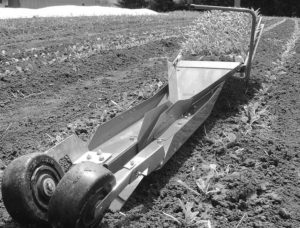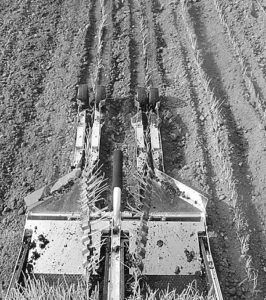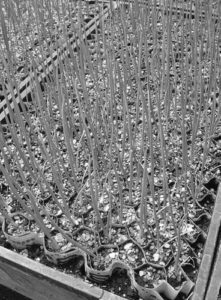Incredible Innovations from Overseas: Introducing the Japanese Paper Pot Transplanter

The paper pot transplanter, loaded up with a flat of greens. Few moving parts means less things that can break! Photo by John Hendrickson, Stone Circle Farm
Incredible Innovations from Overseas: Introducing the Japanese Paper-Pot Transplanter
If I said you could put 264 transplants in the ground in less than a minute all by yourself, with no motorized equipment, and no stooping and bending, you’d probably tell me I was full of… bunk. Or something worse. But it’s true, and the innovative equipment that makes it possible is finding its way onto farms in the Northeast.
The Paper Pot System
It starts with special paper pots, 264 per tray, which are held together with a water-based glue. They arrive flat and unfold to a honeycomb pattern. Farmers fill the paper pots with potting mix and seed them by hand or with a special seeding tray similar to a vacuum seeder but with no power source. The process, to this point, is quite similar to what many Northeast farmers already use to create flats of field-ready transplants.

Plant 500 starts in a minute with the two-row transplanter – still lightweight, still pulled by hand. Photo by John Hendrickson, Stone Circle Farm
When they’re hardened off and ready to go in the ground, the labor-saving really begins. Bed preparation needs to be done just as it would be for hand- or water wheel transplanting. But in this case, the work of putting those little plants in the ground will be done by a light-weight transplanting machine that is pulled by hand. Farmers place a single tray of the paper pots in it, anchor the end pot into the soil, and then simply pull the machine along the row. No engine to fuel, few moving parts to maintain, and little soil compaction. The transplanter makes a furrow and packs the soil down over each plant.
Because the paper pots are connected to each other in long paper chains, they simply feed themselves off the back of the transplanter and into the furrow. John Hendrickson, a farmer who brought this technology to the US, can put 264 onion plants in the ground in well under a minute. Seeing is believing: search “paper pot transplanter” on YouTube and you’ll find some good visuals.
A Tool for Everyone?
Sound too good to be true? Well, it might be, depending on your situation. If your soil is too rocky, too heavy with clay, or just too wet, the transplanter won’t perform well, although there is a model with a longer furrow shank that can improve results.
If your farm specializes in cabbage, broccoli, squash, tomatoes, or peppers—any plant requiring more than 6-in spacing—this system won’t work, because the paper pots come with a maximum 6-in-long paper chain between them. Also, the cell size of the paper pots is too small to grow a large pepper or tomato transplant.
“It’s a great system if you have the right soil and the right conditions – everything needs to be dialed in just right for it to work the way it’s meant to,” says Andy Fellenz of Fellenz Family Farm in Phelps, NY. “We have the best results with [the transplanter] in the hoophouse because it’s been managed more intensively to improve soil texture and I can control moisture easily. Out in the field, we have to spend more time with bed prep, but it’s still faster than hand-transplanting.”
The paper pot transplanting system also works very well for many cut flower crops, including sunflowers, Amaranthus, Celosia, snapdragons and many kinds of grasses including sorghums, millets, canary grass, and pearl millet. It is of course ideal for ornamental alliums.
Financial Analysis

Tray of onions in long-chain paper pots, ready to go in the ground. Photo by John Hendrickson, Stone Circle Farm
The complete transplanter system can cost less than $2,000 to over 4,000 depending on your farm scale and which model and accessories you choose. Andy Fellenz, who uses it to plant onions, spinach, lettuce, multiple asian greens, beets, daikon radish, and hakurei turnips on 8 acres of vegetable crops, estimates that it will pay for itself in less than two seasons. He figures this based on labor savings, pointing out that for farms without hired labor, it may be harder to justify these savings. But he also uses the transplanter to get 2 additional cycles of greens from his hoophouses each year, which translates directly to extra money in his pocket.
John Hendrickson, whose farm is in WI, says a farmer he knows in his area reported putting 300 onion transplants in the ground per hour, using a water wheel transplanter and a crew of at least 3 people. Using his paper pot transplanter, John and one other person put in an average of 1400 an hour in a 5-hour day– an incredible savings when you consider that they had fewer workers and no need to pay to keep a tractor running all day. “And it’s easier on your body, too,” John adds, “because there’s virtually no bending or crawling on your hands and knees with the paper pot transplanter.”
“I’m not sure I’d plant many onions, shallots, leeks, and scallions on my farm if it weren’t for the paper pot transplanter,“ John says, adding, “There is a two-row unit that plants things twice as fast.”
Organic Certification
Both John and Andy are certified organic. Because John was the first person in the country to use the paper pot system, it took some work to get official approval from his certifier, Midwest Organic Services Association (MOSA). “It was difficult because the product doesn’t fall under any categories of the USDA National Organic Program. In the end, MOSA decided that it was allowable because paper mulches are OK. Now NOFA-VT, NOFA-NY, MOFGA, and Washington State certifiers have all approved this system.”
There is another interesting product coming from Japan: larger non-chain paper pots. These could be used to start crops like tomatoes that require a bigger pot and a wider planting distance. They could also be used by growers who sell transplants and don’t want to rely so heavily on plastic cell trays. But for now, these larger pots are not available without a fungicide impregnation, so they are not suitable for certified organic operations. John is hoping to convince the Japanese manufacturer to make them with the same technique they use for the smaller paper chain pots.
Learn More
John started a new company, Small Farm Works LLC, to import and distribute this transplanting system. Visit his site to see demos, find out specific prices, and learn more about the system.


I was wondering if I can plant sorghum in the paper pots and what size would they be in. How can I purchase them? How can I purchase less than one case?
Why not plant tomatoes in every other pot to get enough spacing between them?
Who invented it and When?
Hi Casey,
I had a hard time finding who invented the Japanese Paper Pot transplanter, but this blog said, “developed by the Nippon Sugar Beet Manufacturing Company, Ltd., the largest sugar beet producer in Asia, paper pots took off quickly in Japan, where they have been in widespread use for years; they are relatively new to North America.” You can read more here: https://www.growingformarket.com/articles/farming-lean-with-paper-pots.
We do not endorse any of the information from this website, but I think it is a good starting point for more research!